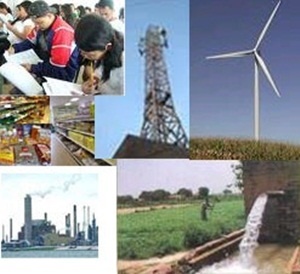India’s economy expanded 13.5 per cent in the April-June quarter of the current financial year (2022-23), helped by high growth in the construction sector and contact-based services, supported by robust domestic demand and capital expenditure by the government.

Real GDP or gross domestic product (GDP) at constant (2011-12) prices is estimated to have attained a level of Rs36.85 lakh crore in Q1 2022-23, against Rs32.46 lakh crore in Q1 2021-22, showing a growth of 13.5 per cent compared with a growth of 20.1 per cent in Q1 2021-22.
This is the fastest pace of growth of the economy in the past 12 months. In the previous three quarters since July 2021, the economy had grown 8.4 per cent, 5.4 per cent and 4.1 per cent, respectively.
The economy had contracted 23.9 per cent in the April-June quarter of 2020 in the aftermath of the first wave of the Covid-19 pandemic, but swung back with a growth rate of 20.1 per cent in the same quarter a year after in 2021.
Nominal GDP or GDP at current prices in Q1 2022-23 is estimated to have grown 26.7 per cent to Rs64.95 lakh crore, compared with Rs51.27 lakh crore in Q1 2021-22. The economy had attained a growth rate of 32.4 per cent in Q1 2021-22.
Gross value added (GVA) for mining and quarrying grew at 6.5 per cent, seemingly reflecting the impact of high global commodity prices over the last few months. Manufacturing growth, meanwhile, was 4.8 per cent after having contracted by 0.2 per cent in January-March.
However, close-contact services witnessed a rebound, as was expected, with the Omicron variant-led third wave of the coronavirus pandemic limited to the first quarter of 2022. In the second quarter, data released today showed, that the activities like 'Trade, Hotels, Transport, Communication and Services related to Broadcasting Industry’ saw GVA jump by 25.7 per cent compared to an increase of 5.3 per cent in January-March.
The overall GVA growth was 12.7 per cent for the April-June 2022-23 quarter.
While the other sectors also posted smart year-on-year increases, they were moderated by the favourable base effect.
The quarterly estimates of national accounts are based on data sourced from various ministries/ departments/ private agencies. Sector-wise estimates have been compiled using indicators like Index of Industrial Production (IIP), financial performance of listed companies in the private corporate sector based on available quarterly financial results, crop production targets for 2022-23, production targets for major livestock products for 2022-23, fish production, production/ consumption of cement and steel, net tonne kilometres and passenger kilometres for railways, passenger and cargo traffic handled by airlines, cargo traffic handled at major sea ports, sales of commercial vehicles, bank deposits and credits, accounts of central and state governments, etc, available for Q1 2022-23.
Going forward, economists expect GDP to face downside risk due to the tightening of monetary policy by the RBI and higher oil and commodity prices. The Reserve Bank of India had, however, predicted the first quarter economic growth rate to be 16.2 per cent.
GDP is derived as the sum of the gross value added (GVA) at basic prices, plus all taxes on products, less all subsidies on products. The total tax revenue used for GDP compilation includes non-GST revenue as well as GST revenue.
For obtaining taxes on products at constant prices, the National Statistical Office (NSO) has used the extrapolation of volume growth of taxed goods and services aggregated to get the total volume of taxes.
NSO has used the latest information available on the website of Controller General of Accounts (CGA) and the Comptroller and Auditor General of India (CAG) for estimating taxes on products and subsidies on products at current prices.
Latest available data on the CGA and CAG websites for revenue expenditure, interest payments, subsidies etc, was used for estimating Government Final Consumption Expenditure (GFCE).
The RBI expects India's GDP to grow 6.2 per cent, 4.1 per cent, and 4.0 per cent, respectively, in the final three quarters of the current financial year.























